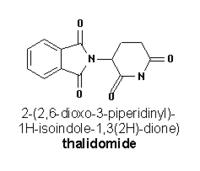Sponsored by: University of Chicago Cancer Research Center and National Cancer Institute (NCI)
RATIONALE: Thalidomide may stop the growth of cancer by stopping blood flow to the tumor. Drugs used in chemotherapy such as irinotecan use different ways to stop tumor ceils from dividing so they stop growing or die. Combining thalidomide with irinotecan may kill more tumor cells.
PURPOSE: Randomized phase I trial to study the effectiveness of combining thalidomide with irinotecan in treating patients who have metastatic or unresectable solid tumors.
Study Type: Interventional
Study Design: Treatment
OBJECTIVES:
* Determine whether thalidomide alters the pharmacokinetics of irinotecan in patients with advanced solid tumors.
* Determine whether irinotecan alters the pharmacokinetics of thalidomide in these patients.
* Determine the toxicity of this regimen in these patients.
* Determine the observed antitumor response in patients treated with this regimen.
OUTLINE: This is a randomized study. Patients are randomized to 1 of 2 treatment arms.
* Arm I: Patients receive irinotecan IV over 90 minutes on days 1 and 22 and oral thalidomide once daily on days 15-28.
* Arm II: Patients receive irinotecan as in arm I and oral thalidomide once daily on days -6 to 7. All patients undergo disease reevaluation at 6 weeks. Patients with stable or responsive disease may receive additional courses comprising irinotecan IV on day 1 and oral thalidomide once daily on days 1-21. Courses repeat every 21 days in the absence of disease progression or unacceptable toxicity.
Ages eligible for study: 18 years and above, both genders
Inclusion Criteria:
* Histologically confirmed malignant solid tumor
* Metastatic or unresectable
* Standard curative or palliative therapy is no longer effective or does not exist
* Measurable or assessable disease
* No uncontrolled brain metastases
* Patients with brain metastases are eligible provided the following are true:
* Stable neurologic status
* At least 4 weeks since prior steroids or anticonvulsants
* No neurologic dysfunction that would confound evaluation
Patient Characteristics:
* Performance status
* Karnofsky 70-100%
Life expectancy
* More than 12 weeks
Hematopoietic
* WBC at least 3,000/[mm.sup.3]
* Absolute neutrophil count at least 1,500/[mm.sup.3]
* Platelet count at least 100,000/[mm.sup.3]
Hepatic
* Bilirubin normal
* AST and ALT no greater than 2.5 times upper limit of normal
Renal
* Creatinine normal OR
* Creatinine clearance at least 60 mL/min
Cardiovascular
* No symptomatic congestive heart failure
* No unstable angina pectoris
* No cardiac arrhythmia
Gastrointestinal
* No history of inflammatory bowel disease requiring therapy
* NO chronic diarrhea syndromes
* No paralytic ileus
Other
* Not pregnant or nursing
* Negative pregnancy test
* Fertile female patients must use 2 forms of effective contraception, including 1 highly effective method, for at least 4 weeks before, during, and for 4 weeks after study participation
* Male patients must use effective barrier contraception during and for 4 weeks after study participation
* No prior allergic reaction attributed to compounds of similar chemical or biological composition to study drugs
* No uncontrolled seizure disorder
* No other concurrent uncontrolled illness that would preclude study participation
* No psychiatric illness or social situation that would preclude study compliance
* No ongoing or active infection
* No significant traumatic injury within the past 28 days
* No serious, nonhealing wounds or ulcers
* No bone fractures
* No preexisting peripheral neuropathy grade 2 or greater
PRIOR CONCURRENT THERAPY:
Biologic therapy
* At least 4 weeks since prior biologic therapy
Chemotherapy
* At least 4 weeks since prior chemotherapy (6 weeks for nitrosources or mitomycin)
Radiotherapy
* At least 4 weeks since prior radiotherapy
Surgery
* More than 28 days since prior major surgical procedure or open biopsy
Other
* At least 4 weeks since prior investigational therapy
* No concurrent combination antiretroviral therapy for HIV-positive patients
* No other concurrent investigational or commercial agents or therapies for the malignancy
Location and Contact Information
University of Chicago Cancer Research Center, Chicago, Illinois, 60637, United States; Mark J. Ratain, MD Study Chair, University of Chicago Cancer Research Center Tel: 773-702-4400
Illinois
A total of 12 patients (6 per treatment arm) will be accrued for this study.
Study ID Numbers CDR0000304517; UCCRC-12044B; NCI-5814
NLM Identifier NCT00062127
COPYRIGHT 2003 Journal of Drugs in Dermatology
COPYRIGHT 2003 Gale Group



